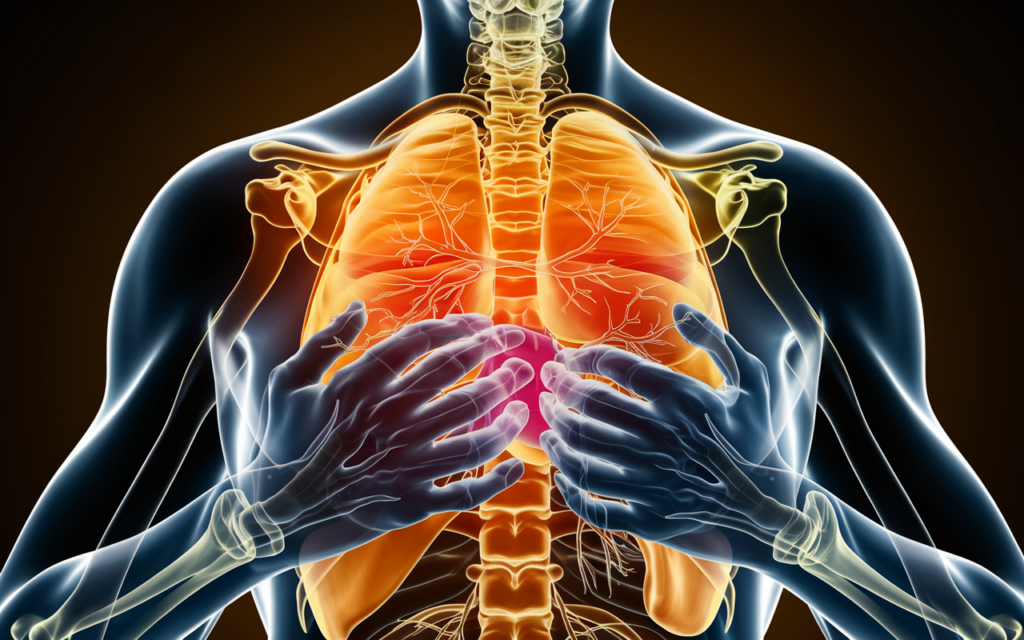Understanding Mesothelioma Symptoms from Early to End-Stage
A Comprehensive Guide to Recognizing and Managing Mesothelioma Symptoms at Every Stage
Introduction
Understanding Mesothelioma Symptoms from Early to End-Stage: Mesothelioma is a rare and aggressive form of cancer primarily caused by exposure to asbestos, a naturally occurring mineral once widely used in construction, manufacturing, and other industries. This insidious disease affects the mesothelium, a protective lining covering internal organs such as the lungs, abdomen, heart, and testicles. Unlike many cancers, mesothelioma often remains asymptomatic for decades after initial exposure, making early detection challenging. By the time symptoms emerge, the disease may have progressed significantly, complicating treatment options.

Recognizing the symptoms of mesothelioma at its various stages is crucial for improving patient outcomes. Early diagnosis can lead to more effective interventions, better quality of life, and potentially longer survival rates. However, because the early signs of mesothelioma resemble those of common illnesses like colds or flu, they are frequently overlooked or misdiagnosed.
This article aims to provide an in-depth exploration of the symptoms of mesothelioma across its stages, from very early indicators to advanced manifestations. We will also examine how asbestos exposure leads to this devastating condition, discuss diagnostic methods, and explore palliative care and treatment options. Additionally, we will highlight the importance of seeking medical attention promptly if you suspect exposure to asbestos or notice persistent symptoms. Let us delve into the complexities of this disease to empower individuals with knowledge that could save lives.
1. What is Mesothelioma?
Definition and Types of Mesothelioma
Mesothelioma is a malignant tumor originating in the mesothelial cells, which line the body’s internal organs. The most common types of mesothelioma include:
- Pleural Mesothelioma : Affects the lining of the lungs (pleura). It accounts for approximately 75% of all cases.
- Peritoneal Mesothelioma : Develops in the abdominal cavity lining (peritoneum), representing about 20% of cases.
- Pericardial Mesothelioma : Occurs in the lining around the heart (pericardium) and is extremely rare, accounting for less than 1% of cases.
- Testicular Mesothelioma : Arises in the tunica vaginalis, the membrane surrounding the testicles, and is the rarest form of the disease.
Each type presents distinct symptoms depending on the affected organ system, but all share a common origin—exposure to asbestos fibers.
Primary Cause: Asbestos Exposure
Asbestos was extensively used in industries due to its heat resistance, durability, and affordability. When disturbed, microscopic asbestos fibers become airborne and can be inhaled or ingested. These fibers lodge deep within the tissues, causing inflammation, scarring, and genetic mutations over time. Eventually, these changes result in the development of mesothelioma.
Why Symptoms Often Appear Decades After Exposure
The latency period for mesothelioma ranges from 20 to 50 years, meaning symptoms typically do not manifest until decades after initial exposure. During this time, asbestos fibers remain embedded in the tissue, gradually triggering cellular damage. This long delay contributes to the difficulty of diagnosing mesothelioma early and underscores the importance of vigilance among individuals with known asbestos exposure histories.
2. Early Signs and Symptoms of Mesothelioma

Very Early Symptoms of Mesothelioma
In its earliest stages, mesothelioma exhibits subtle signs that are easily dismissed as harmless. These “very early” symptoms include:
- Mild Fatigue or Unexplained Tiredness : Persistent exhaustion without an apparent cause can signal underlying health issues.
- Occasional Shortness of Breath (Dyspnea) : Difficulty breathing during physical activity or rest may indicate lung involvement.
- Slight Chest or Abdominal Discomfort : Mild pain or pressure in the chest or abdomen might precede more severe symptoms.
These vague complaints rarely prompt immediate concern, allowing the disease to progress undetected.
Early Signs and Symptoms of Mesothelioma
As the disease advances, more noticeable symptoms begin to appear. These include:
- Persistent Dry Cough : A chronic cough lasting several weeks or months may signify irritation in the respiratory tract.
- Mild Pain in the Chest or Abdomen : Localized discomfort increases as tumors grow and press against surrounding structures.
- Unexplained Weight Loss : Significant weight loss without dietary changes or increased exercise is a red flag for serious illness.
- Night Sweats or Low-Grade Fever : Recurrent fevers or excessive sweating, especially at night, suggest systemic inflammation.
Why Early Symptoms Are Often Mistaken for Common Illnesses
The nonspecific nature of early mesothelioma symptoms makes them easy to confuse with benign conditions such as bronchitis, pneumonia, or gastrointestinal disorders. Many patients dismiss these warning signs or attribute them to aging, stress, or lifestyle factors, delaying proper evaluation and diagnosis.
3. Common Symptoms of Mesothelioma
Four hallmark symptoms characterize mesothelioma at intermediate stages:
- Shortness of Breath (Due to Pleural Effusion) : Fluid accumulation between the layers of the pleura impairs lung expansion, leading to dyspnea.
- Chest or Abdominal Pain : Intensifying pain results from tumor growth and nerve compression.
- Persistent Cough (Sometimes with Blood) : Chronic coughing may produce blood-tinged sputum, indicating advanced lung damage.
- Fatigue and Weakness : Profound exhaustion persists despite adequate rest, reflecting the body’s struggle against cancer.
Which of These Are Typical Symptoms of Mesothelioma?
While these symptoms overlap with other respiratory or abdominal conditions, their persistence and severity warrant further investigation. For example, shortness of breath accompanied by pleural effusion strongly correlates with pleural mesothelioma, while abdominal swelling points toward peritoneal mesothelioma.
4. Signs and Symptoms of Mesothelioma by Type
Pleural Mesothelioma
Pleural mesothelioma predominantly affects the lungs and surrounding structures. Key symptoms include:
- Chest Pain : Sharp or dull pain localized to one side of the chest.
- Pleural Effusion : Excess fluid buildup in the pleural space, contributing to breathing difficulties.
- Difficulty Breathing : Progressive shortness of breath worsens with exertion or lying down.
Peritoneal Mesothelioma
Peritoneal mesothelioma targets the abdominal cavity. Its symptoms differ slightly:
- Abdominal Swelling : Distension caused by fluid accumulation or tumor growth.
- Nausea and Vomiting : Gastrointestinal distress due to organ compression.
- Bowel Changes : Constipation or diarrhea resulting from impaired digestion.
Pericardial Mesothelioma
Pericardial mesothelioma involves the heart and its surrounding sac. Symptoms include:
- Heart Palpitations : Irregular heartbeat patterns.
- Chest Pain : Severe discomfort radiating to the arms or shoulders.
- Difficulty Breathing : Shortness of breath even at rest.
Testicular Mesothelioma
Testicular mesothelioma manifests as:
- Swelling or Lumps in the Testicles : Visible or palpable abnormalities prompting medical evaluation.
5. Cause and Symptoms of Mesothelioma
How Asbestos Exposure Leads to Mesothelioma
When asbestos fibers enter the body, they penetrate deeply into tissues where they cannot be expelled. Over time, these fibers irritate and scar the mesothelial lining, disrupting normal cell function. Genetic mutations occur, enabling abnormal cell proliferation and tumor formation.
The Link Between Asbestos Fibers and Symptom Development
Asbestos fibers trigger chronic inflammation, oxidative stress, and DNA damage. These processes culminate in the emergence of characteristic symptoms, which vary based on the location and extent of tumor growth.
Why Symptoms Take 20–50 Years to Appear
The prolonged latency period reflects the slow progression of cellular changes induced by asbestos exposure. Initially, the body attempts to repair damaged tissue, masking overt symptoms. Eventually, however, the cumulative effects overwhelm natural defenses, leading to clinical presentation.
6. End-of-Life Symptoms of Mesothelioma
What Are the End-of-Life Symptoms of Mesothelioma?
In advanced stages, mesothelioma becomes increasingly debilitating. Typical end-of-life symptoms include:
- Severe Pain in the Chest or Abdomen : Unrelenting discomfort requiring aggressive pain management.
- Difficulty Breathing (Advanced Pleural Effusion) : Critical fluid buildup severely restricts lung function.
- Extreme Fatigue and Weakness : Exhaustion limits daily activities and mobility.
- Loss of Appetite and Significant Weight Loss : Malnutrition exacerbates overall frailty.
- Confusion or Cognitive Changes : Oxygen deprivation impacts brain function, causing disorientation.
Emotional and Psychological Symptoms in Advanced Stages
Patients nearing the end of life often experience anxiety, depression, and existential distress. Family members may also face emotional challenges, underscoring the need for comprehensive support systems.
7. Diagnosing Mesothelioma Based on Symptoms
Differentiating Mesothelioma Symptoms from Other Conditions
Doctors rely on symptom patterns, patient history, and diagnostic testing to distinguish mesothelioma from similar diseases. For instance, pleural effusion associated with mesothelioma differs from that seen in congestive heart failure or tuberculosis.
Diagnostic Tests
- Imaging Studies : X-rays, CT scans, and MRIs visualize tumors and assess spread.
- Biopsies : Tissue samples confirm malignancy and identify specific cell types.
- Blood Tests : Biomarkers like MESOMARK and soluble mesothelin-related peptides aid diagnosis.
Importance of Sharing Detailed Symptom History
Accurate communication with healthcare providers ensures timely and accurate diagnosis. Patients should disclose any history of asbestos exposure, no matter how distant.
8. Managing Mesothelioma Symptoms
Palliative Care for Symptom Relief
Palliative care focuses on alleviating suffering through medication, therapy, and supportive services. Techniques include:
- Pain management using opioids or nerve blocks.
- Drainage procedures for pleural effusions.
- Nutritional counseling to address appetite loss.
Treatment Options
Standard treatments aim to extend survival and improve quality of life:
- Surgery : Removal of tumors when feasible.
- Chemotherapy : Systemic drugs targeting cancer cells.
- Radiation Therapy : Localized beams destroying malignant tissue.
Lifestyle Changes to Improve Quality of Life
Adopting healthy habits complements medical interventions:
- Regular exercise tailored to individual capabilities.
- Balanced nutrition rich in fruits, vegetables, and lean proteins.
- Stress reduction techniques such as meditation or counseling.
9. Conclusion
Mesothelioma poses a formidable challenge due to its stealthy onset and rapid progression. Recognizing symptoms early offers the best chance for effective treatment and improved outcomes. Individuals with a history of asbestos exposure must remain vigilant and seek medical advice promptly upon noticing suspicious signs. Advances in research continue to enhance our understanding of this complex disease, offering hope for future breakthroughs.




